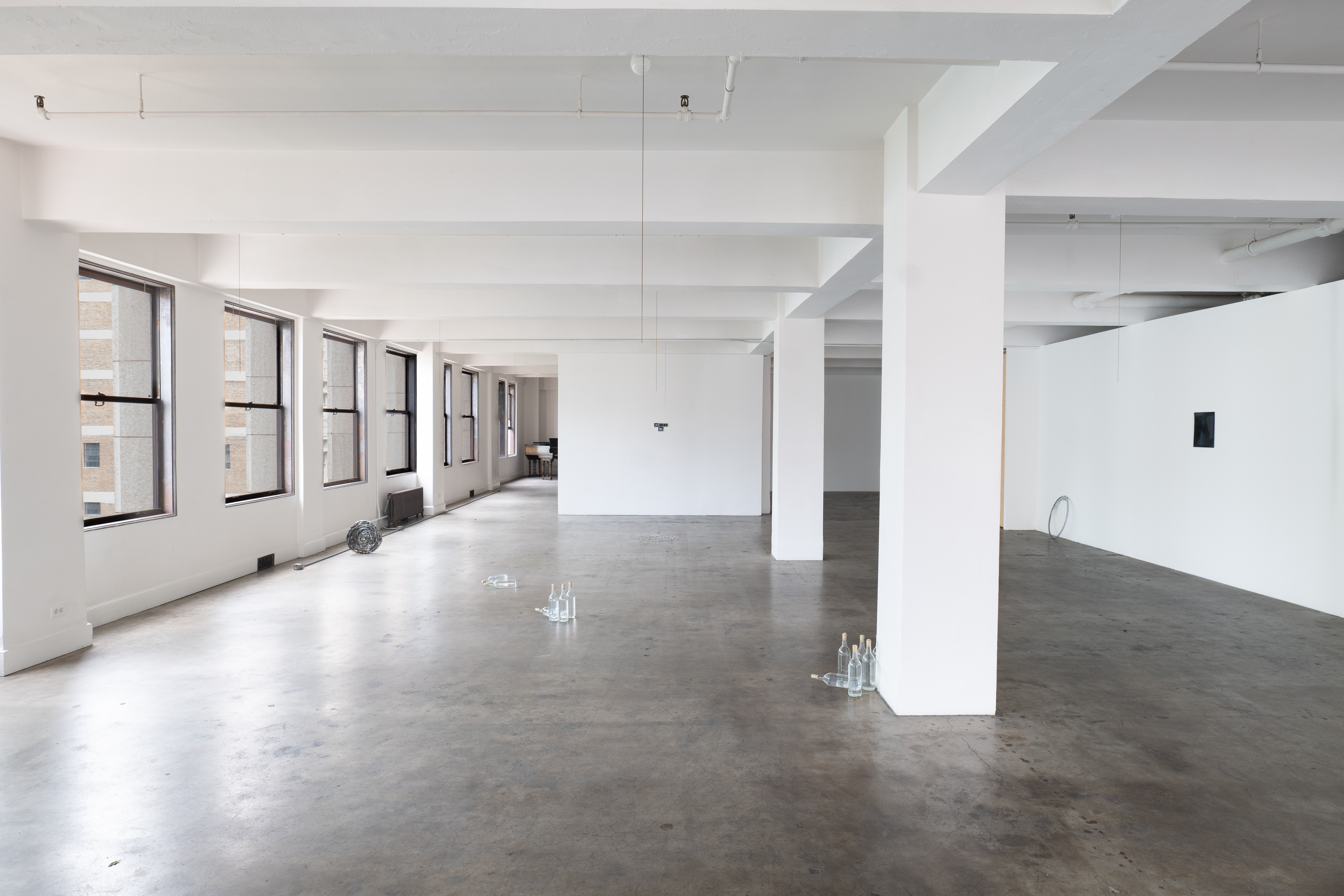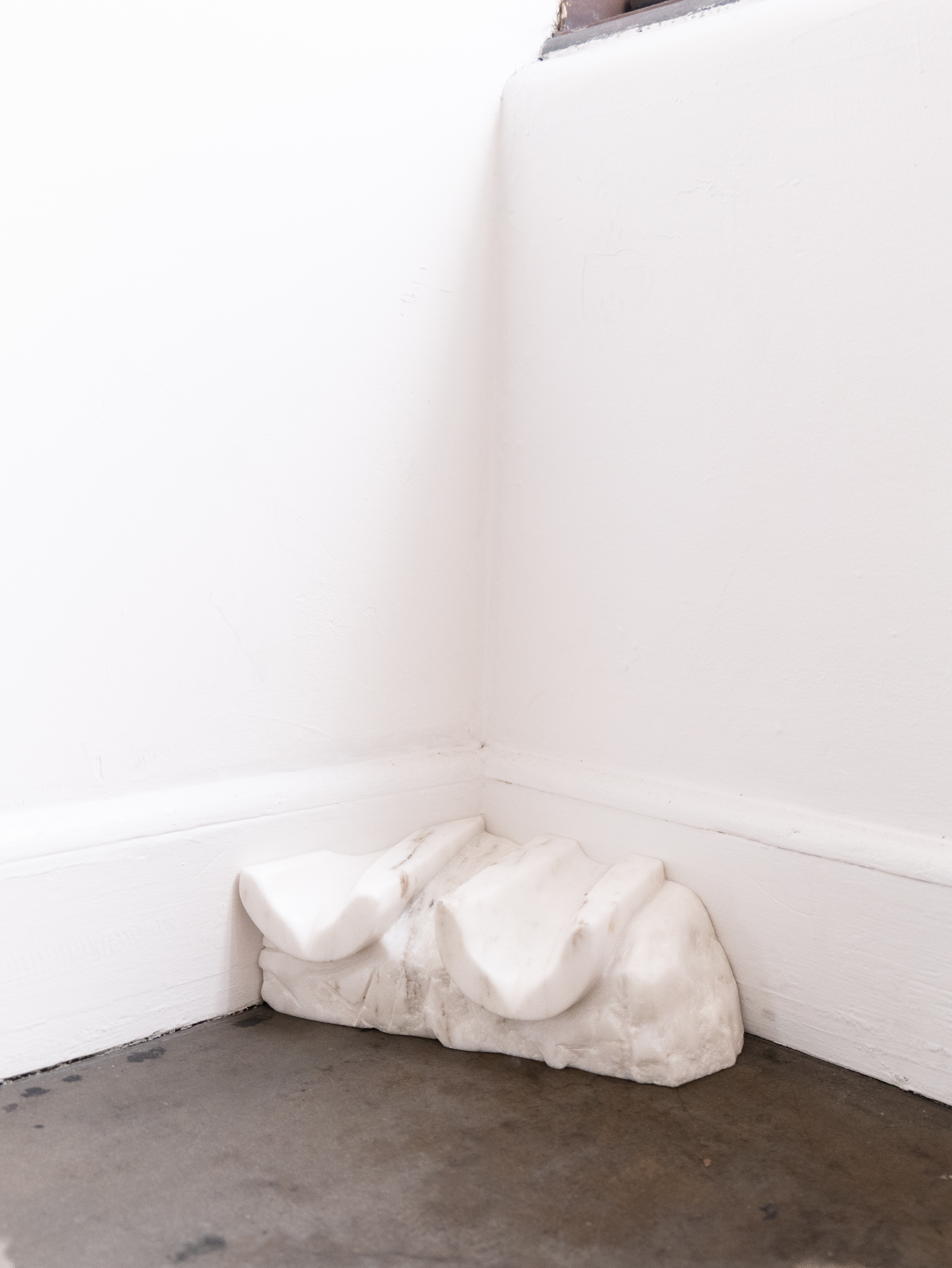by the lattice
curated by Mara Hassan
Giovanni’s Room, Los Angeles
July 28 - August. 31, 2024
Jordan Loeppky-Kolesnik, K.R.M. Mooney, Hamish Pearch, Bat-Ami Rivlin, Solomon Rousseau, P. Staff, Andrew Sungtaek and Carrie Yamaoka
It was in 1938 when Bachelard published his Psychoanalysis of Fire, turning to the element as both a subject of psychoanalysis and an object of phenomenological study. This set in motion his unique, integrated philosophy that looked to the matter that constituted form; he would subsequently turn to the remaining forces of water (1942), air (1943), and earth (1948). By his hand, a hazy groundwork for new materialist thought—complicating the tenets of Cartesian dualism—was securing shape in the former half of the 20th century.
He wrote in Water and Dreams: “... when forms, mere perishable forms and vain images—perpetual change of surfaces—are put aside, images of matter are dreamt substantially and intimately. They have weight; they constitute a heart.” Again, in Earth and Reveries of Will, he observed: “[a] kind of objective characterology begins to emerge when we imagine behind form the resistance of matter.” It was the recalcitrant nature of the elements that pulled at Bachelard, his memories, and aspirations; and it was in their agential capacity that he observed a slow, warm affinity. In opposition to the hubris of his contemporaries, he wrote forward an expanded reconsideration of the ontological beyond man. And with this hubris dislodged from aesthetic and natural judgment, materiality itself takes on new shapes and functions, ones that exist beyond their human affordances.
Such an expansion of formal considerations falls well in line with Robert Morris’ emphasis on phenomenology in his delineation of the minimalist tradition. In his seminal Notes on Sculpture (1966), he spends much time discussing the novelty of his expansion of formal relationships, which make their way out from the confines of unitary objects and towards their constituting spatial and temporal circumstances. Internal formal engagements—between details of color, shape, iconography, and medium—are reterritorialized expansively, and superseded by interactions with light, orientation, and perception. The object becomes just one node of many that when in concert with other nodes, coalesce into a larger phenomenon in which the subject’s body, too, is in dialogue. He writes:
“While the work must be autonomous in the sense of being a self-contained unit for the formation of the gestalt, the indivisible and undissolvable whole, the major aesthetic terms are not in but dependent upon this autonomous object and exist as unfixed variables that find their specific definition in the particular space and light and physical viewpoint of the spectator.”
Here, Morris highlights how stable forms gather and produce unstable meaning through their indexing of the environment, as well as viewers’ bodies. Perception and experience construct the object in question, which relies on space and time—axes through which we are also constituted—to find us.
Following Bachelard and Morris, by the lattice takes processed geomaterials that constitute Claud Beelman’s Ninth and Broadway building as a point of departure. Housing Giovanni’s Room, Beelman’s Ninth, and Broadway is structured by steel, copper, iron, and glass, with ferroconcrete and architectural terracotta flesh. The objects in this exhibition are tethered to one another by their engagements with their respective geo-materialities and the spatial circumstances by which they are constituted. A phenomenology of the industrial is, in other words, pursued. Perception and experience are foregrounded through an emphasis on reflection, change, and light. Inspired by the gallery’s views from the 6th floor, the exhibition also deeply considers sunlight’s transitory nature and its engagement with its surrounding high-rises—Beelman’s other children.
https://giovannisroomla.com/lattice
curated by Mara Hassan
Giovanni’s Room, Los Angeles
July 28 - August. 31, 2024
Jordan Loeppky-Kolesnik, K.R.M. Mooney, Hamish Pearch, Bat-Ami Rivlin, Solomon Rousseau, P. Staff, Andrew Sungtaek and Carrie Yamaoka
It was in 1938 when Bachelard published his Psychoanalysis of Fire, turning to the element as both a subject of psychoanalysis and an object of phenomenological study. This set in motion his unique, integrated philosophy that looked to the matter that constituted form; he would subsequently turn to the remaining forces of water (1942), air (1943), and earth (1948). By his hand, a hazy groundwork for new materialist thought—complicating the tenets of Cartesian dualism—was securing shape in the former half of the 20th century.
He wrote in Water and Dreams: “... when forms, mere perishable forms and vain images—perpetual change of surfaces—are put aside, images of matter are dreamt substantially and intimately. They have weight; they constitute a heart.” Again, in Earth and Reveries of Will, he observed: “[a] kind of objective characterology begins to emerge when we imagine behind form the resistance of matter.” It was the recalcitrant nature of the elements that pulled at Bachelard, his memories, and aspirations; and it was in their agential capacity that he observed a slow, warm affinity. In opposition to the hubris of his contemporaries, he wrote forward an expanded reconsideration of the ontological beyond man. And with this hubris dislodged from aesthetic and natural judgment, materiality itself takes on new shapes and functions, ones that exist beyond their human affordances.
Such an expansion of formal considerations falls well in line with Robert Morris’ emphasis on phenomenology in his delineation of the minimalist tradition. In his seminal Notes on Sculpture (1966), he spends much time discussing the novelty of his expansion of formal relationships, which make their way out from the confines of unitary objects and towards their constituting spatial and temporal circumstances. Internal formal engagements—between details of color, shape, iconography, and medium—are reterritorialized expansively, and superseded by interactions with light, orientation, and perception. The object becomes just one node of many that when in concert with other nodes, coalesce into a larger phenomenon in which the subject’s body, too, is in dialogue. He writes:
“While the work must be autonomous in the sense of being a self-contained unit for the formation of the gestalt, the indivisible and undissolvable whole, the major aesthetic terms are not in but dependent upon this autonomous object and exist as unfixed variables that find their specific definition in the particular space and light and physical viewpoint of the spectator.”
Here, Morris highlights how stable forms gather and produce unstable meaning through their indexing of the environment, as well as viewers’ bodies. Perception and experience construct the object in question, which relies on space and time—axes through which we are also constituted—to find us.
Following Bachelard and Morris, by the lattice takes processed geomaterials that constitute Claud Beelman’s Ninth and Broadway building as a point of departure. Housing Giovanni’s Room, Beelman’s Ninth, and Broadway is structured by steel, copper, iron, and glass, with ferroconcrete and architectural terracotta flesh. The objects in this exhibition are tethered to one another by their engagements with their respective geo-materialities and the spatial circumstances by which they are constituted. A phenomenology of the industrial is, in other words, pursued. Perception and experience are foregrounded through an emphasis on reflection, change, and light. Inspired by the gallery’s views from the 6th floor, the exhibition also deeply considers sunlight’s transitory nature and its engagement with its surrounding high-rises—Beelman’s other children.
https://giovannisroomla.com/lattice








